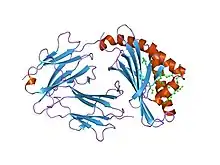CD1b
T-cell surface glycoprotein CD1b is a protein that in humans is encoded by the CD1B gene.
CD1b belongs to group 1 of CD1 family of transmembrane glycoproteins. CD1 molecules are expressed on the surface of numerous different human antigen presenting cells (DCs, monocytes and some thymocytes). This specialised group of glycoproteins present self and non-self lipid-based antigens to specific αβ T-cells.[3] CD1 molecules are structurally related to the major histocompatibility complex (MHC), belonging to MHC class I-like genes. The human CD1 locus is found on chromosome 1 and contains five nonpolymorphic genes (CD1a, CD1b, CD1c, CD1d and CD1e).[4][5]
Structure and function
CD1b molecules (as well as other CD1 and classical MHC I molecules) are formed by membrane-bound glycoprotein composed of three extracellular domains (α1,α2,α3). These extracellular domains are non-covalently associated with β2 microglobulin (which has the function of stabilising protein). This organization forms a narrow hydrophobic binding groove that accommodates lipid-based antigens. The binding groove is made up of four broadly interconnected pockets that are occupied by the alkyl chains of glycolipid and two detergent molecules.[6][7] Compared to other CD1 molecules this unique arrangement of CD1b provides the possibility of binding a wide spectrum of antigens with various lengths of alkyl chain. Alkyl components of antigens are attached in the hydrophobic groove and a hydrophilic part stands out from the CD1b molecule and thus provides to the TCR a place to bind.[8]
CD1b molecule has the largest antigen-binding cleft within the CD1 family. Whereas the microbial lipids tend to have longer alkyl chains than self endogenous lipids it seems that CD1b is specifically adapted to present microbial lipids (rather than endogenous) to T cells.[7] In the absence of longer microbial lipids, CD1b presents both an endogenous lipid and a scaffold/spacer lipid(s).[9]
Clinical significance
When the immune system does not distinguish self and non-self antigens, it leads to an autoreactive T-cell response. Autoreactive CD1b can recognize for example phosphatidylglycerol, which is common for bacteria but also mammalian mitochondria. This autoantigen is released during a bacterial infection or mitochondrial stress. CD1b also presents endogenous gangliosides to specific T cells so they can commence autoimmune diseases such as multiple sclerosis.
In contrast with major histocompatibility complexes, CD1 molecules have restricted diversity, it could be an interesting marker for immunotherapy and target for development of new drugs.[10]
Reference
- GRCh38: Ensembl release 89: ENSG00000158485 - Ensembl, May 2017
- "Human PubMed Reference:". National Center for Biotechnology Information, U.S. National Library of Medicine.
- Gras S, Van Rhijn I, Shahine A, Cheng TY, Bhati M, Tan LL, et al. (October 2016). "T cell receptor recognition of CD1b presenting a mycobacterial glycolipid". Nature Communications. 7: 13257. Bibcode:2016NatCo...713257G. doi:10.1038/ncomms13257. PMC 5095289. PMID 27807341.
- "CD1B CD1b molecule [Homo sapiens (human)]". NCBI Gene. National Center for Biotechnology Information, U.S. National Library of Medicine. Retrieved 2019-02-06.
- Jackman RM, Stenger S, Lee A, Moody DB, Rogers RA, Niazi KR, et al. (March 1998). "The tyrosine-containing cytoplasmic tail of CD1b is essential for its efficient presentation of bacterial lipid antigens". Immunity. 8 (3): 341–51. doi:10.1016/S1074-7613(00)80539-7. PMID 9529151.
- "CD1B - T-cell surface glycoprotein CD1b precursor - Homo sapiens (Human) - CD1B gene & protein". Universal Protein Resource (UniProt). Retrieved 2019-02-06.
- Gadola SD, Zaccai NR, Harlos K, Shepherd D, Castro-Palomino JC, Ritter G, et al. (August 2002). "Structure of human CD1b with bound ligands at 2.3 A, a maze for alkyl chains". Nature Immunology. 3 (8): 721–6. doi:10.1038/ni821. PMID 12118248. S2CID 86980.
- Batuwangala T, Shepherd D, Gadola SD, Gibson KJ, Zaccai NR, Fersht AR, et al. (February 2004). "The crystal structure of human CD1b with a bound bacterial glycolipid". Journal of Immunology. 172 (4): 2382–8. doi:10.4049/jimmunol.172.4.2382. PMID 14764708.
- Shahine, Adam (2018). "The intricacies of self-lipid antigen presentation by CD1b". Molecular Immunology. 104: 27–36. doi:10.1016/j.molimm.2018.09.022. PMID 30399491. S2CID 53243699.
- Van Rhijn I, van Berlo T, Hilmenyuk T, Cheng TY, Wolf BJ, Tatituri RV, et al. (January 2016). "Human autoreactive T cells recognize CD1b and phospholipids". Proceedings of the National Academy of Sciences of the United States of America. 113 (2): 380–5. Bibcode:2016PNAS..113..380V. doi:10.1073/pnas.1520947112. PMC 4720340. PMID 26621732.
Further reading
- Murphy K, Weaver C (2016). Janeway's immunobiology (9th ed.). New York, NY: Garland Science/Taylor & Francis Group. ISBN 978-0-8153-4551-0.


